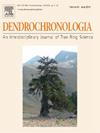Monsoon climatic signal is stronger in wood anatomical traits than in ring widths of Fokienia hodginsii in central Vietnam
IF 2.3
3区 农林科学
Q1 FORESTRY
引用次数: 0
Abstract
Dendrochronological studies conducted in tropical regions in recent decades revealed that some species exhibit annual rings. In Southeast Asia, several ring-width chronologies of Fokienia hodginsii (Dunn) A. Henry & H H.Thomas were established to reconstruct past climatic conditions.
Nevertheless, despite the strong correlations with meteorological data, the climate signal in the ring-width chronologies is robust for the shoulder season of the monsoon. For those interested in intra-annual climate signals, other parameters might prove useful. Information on intra-annual variability is crucial for understanding tree growth processes and climate dynamics in tropical regions. In this study, we explore the potential of wood anatomical parameters for climate reconstruction and for gaining a better understanding of the current climate of Southeast Asia. Microslides from cores of F. hodginsii in central Vietnam were analyzed. Notably, average lumen perimeter and lumen length demonstrated the most robust climate signals. They exhibit stronger correlations than ring width with maximum temperature, precipitation, and the Standardized Precipitation Evapotranspiration Index. The highest correlation (r = 0.5) was observed between lumen area and October-November-December precipitation. Furthermore, earlywood parameters show higher correlations with precipitation than whole ring parameters. The growth of earlywood in F. hodginsii appears to be influenced by climatic conditions during September-October-November of the previous year and April of the current year. Thus, earlywood is generally produced around April, whereas latewood grows during or after April-May-June. This study is the first attempt to use anatomical parameters to reconstruct climate in Southeast Asia and provides valuable insights into the intra-annual growth dynamics of tropical tree rings.
季风气候信号在越南中部hoginsii木材解剖特征上强于环宽
近几十年来在热带地区进行的树木年代学研究表明,一些物种表现出年轮。在东南亚,若干环宽hodginsii (Dunn) A. Henry &;H。H。thomas的建立是为了重建过去的气候条件。然而,尽管与气象数据有很强的相关性,环宽年表中的气候信号对于季风的肩季是稳健的。对于那些对年内气候信号感兴趣的人来说,其他参数可能是有用的。关于年内变率的信息对于了解热带地区树木生长过程和气候动态至关重要。在这项研究中,我们探索木材解剖参数对气候重建的潜力,并更好地了解东南亚当前的气候。对越南中部霍奇金孢子虫岩心的微玻片进行了分析。值得注意的是,平均流明周长和流明长度显示出最强大的气候信号。它们与最高温度、降水和标准化降水蒸散指数的相关性强于环宽。10 - 11 - 12月降水量与管腔面积相关性最高(r = 0.5)。此外,早期木材参数与降水的相关性高于全环参数。在前一年的9 - 10 - 11月和当年的4月,霍奇金银杏早木的生长受气候条件的影响。因此,早木通常在4月左右生产,而晚木在4月至5月至6月期间或之后生长。本研究首次尝试利用解剖学参数重建东南亚地区的气候,为热带树木年轮的年内生长动态提供了有价值的见解。
本文章由计算机程序翻译,如有差异,请以英文原文为准。
求助全文
约1分钟内获得全文
求助全文
来源期刊

Dendrochronologia
FORESTRY-GEOGRAPHY, PHYSICAL
CiteScore
5.50
自引率
13.30%
发文量
82
审稿时长
22.8 weeks
期刊介绍:
Dendrochronologia is a peer-reviewed international scholarly journal that presents high-quality research related to growth rings of woody plants, i.e., trees and shrubs, and the application of tree-ring studies.
The areas covered by the journal include, but are not limited to:
Archaeology
Botany
Climatology
Ecology
Forestry
Geology
Hydrology
Original research articles, reviews, communications, technical notes and personal notes are considered for publication.
 求助内容:
求助内容: 应助结果提醒方式:
应助结果提醒方式:


